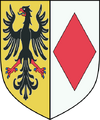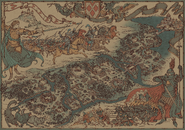Lyria and Rivia is a name used while referring to a confederation of realms in Dol Angra, composed primarily of Lyria and Rivia. Joined for the first time by King Berrik[3] it collapsed and reorganised again a couple times more, which led to saying that "Lyria and Rivia were either at war with each other or conjoined by personal union."[4]
History
Early history
While the region is said to have been populated since ancient times,[5] the majority of its inhabitants settled here in two waves: the first after the Six Years' War in 9th century and the second in the 11th, both comprised mainly ofwar refugees and opponents of Temerian and Cintran rulers. Out of the several principalities and lordships, Lyria and Rivia became prominent. In 1133 Berrik of Lyria ascended the Rivian throne and proclaimed the confederation of both realms.[3] About a generation or two later, king Egon's daughter Impecca married prince Ceran of Cintra, forging a lasting alliance with the kingdom in the mouth of the Yaruga.[5]
13th century
In the first half of the 13th century the kingdoms were conjoined once more, by marriage of Meve of Lyria with Reginald of Rivia.[1] Queen Meve took care of ensuring that both nations had equalrepresentation despite their differences.[4] She continued to rule after her husband's death and became one of the most important political figures of the Northern Realms, considerable enough to attend secret meetings with leaders of the Four Kingdoms.[6]
In July 1267, during the Second Nilfgaard War, Lyria and Rivia were invaded and conquered by Nilfgaard without any formal declaration of war. Meve fled and continued warfare in Aedirn[7] and Angren.[8] The kingdom was finally liberated some time around the Battle of Brenna or shortly beforehand.[9]
Further history
Several centuries later, when the 13th century itself became considered antiquity, the exact location of Rivia became unknown but its coat of arms was remembered.[10]
National Emblems
The most recent coat of arms of the Kingdom was composed of Rivian lozenges, Lyrian eagle and Cintran lions.[5]
The following illustrations have been created by Wiki editors basing on official description and/or depictions.
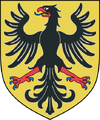
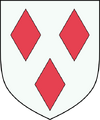
The following illustration has been created by Stanislav Komárek, Sapkowski's associate and translator.
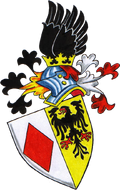
Geography and climate
The realm is adjacent to the Yaruga river and is crossed by Dol Angra valley.[7] Rivia borders Mahakam to the west and its capital touches the mountain range's easternmost massif, Craag Ros hills.[9] Lyria is famous for its picturesque mountains as well: many mages chose to settle there for their beauty.[11] Valleys between the mountains are fertile, allowing cultivation of fruit and vegetables.[4][1]
Society and culture
TBA
Notable Lyrians and Rivians
Locations
Military
For the main article, see Military of Lyria and Rivia.
Rivians and Lyrians are considered amongst the finest crossbowmen in the Continent.[13]
Prior to the start of the 2nd Northern-Nilfgaard war, Lyria and Aedirn had a combined army of approximately 35,000 soldiers. When the war began with Nilfgaard's invasion, they were only able to raise about 13,000, including 3,000 cavalry. In the early days of the invasion, a fifth of these forces were cut off in forts and fortresses. Part of the remaining troop had been withdrawn to defend the wing against light cavalry and Scoia'tael. The remaining army, about six thousand soldiers to include twelve-hundred knights, was beaten in first battle of Aldersberg. The state of the armed forces of Lyria and Rivia after the war may be determined at approx. eight thousand infantrymen who fought as a diversionary force during the last war with Nilfgaard.
Gallery
References
- ↑ 1.00 1.01 1.02 1.03 1.04 1.05 1.06 1.07 1.08 1.09 1.10 1.11 1.12 1.13 1.14 Thronebreaker: The Witcher Tales
- ↑ consistent in books and games
- ↑ 3.0 3.1 Wiedźmin: Gra Wyobraźni
- ↑ 4.0 4.1 4.2 Travel to never-before-seen Kingdoms!
- ↑ 5.0 5.1 5.2 Dynastic descriptions
- ↑ Blood of Elves
- ↑ 7.0 7.1 Time of Contempt
- ↑ Baptism of Fire
- ↑ 9.0 9.1 The Lady of the Lake
- ↑ The Tower of the Swallow
- ↑ Season of Storms
- ↑ 12.0 12.1 in The Witcher game series
- ↑ The Witcher Role-Playing Game



